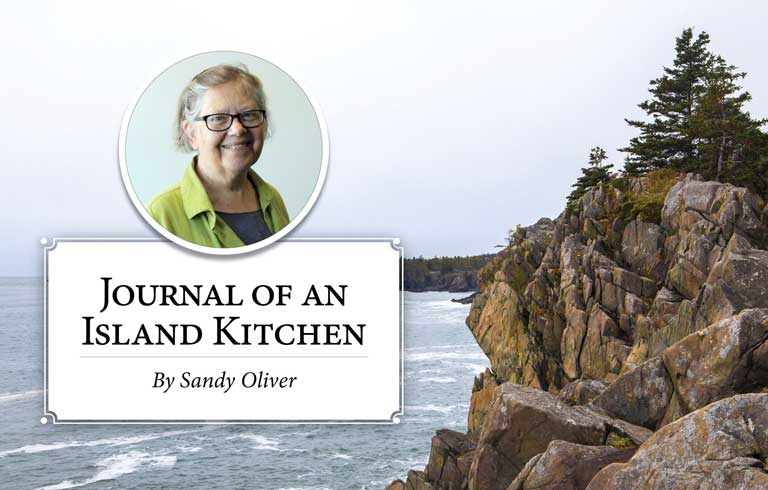Hard times like this pandemic leave us hankering for comfort food: meatloaf, mashed potatoes, mac and cheese, pasta, ice cream. Have you heard about Covid 15? That’s the weight we packed on while stuck at home. But what’s discomfort food?
Food that hurts the cook to prepare. Like sharp points on lobster claw legs, for example. Making a batch of Lobster Newburg for a large wedding years ago left the cook and me with punctured palms. Consider, too, the violence required to crack lobster or crab claws.
Making a batch of Lobster Newburg for a large wedding years ago left the cook and me with punctured palms.
Hot pepper juice stings your eyes even hours after you wash your hands. Onions always make me cry and none of the tricks like holding bread in my mouth ever helped me. When I slice up a lot of them, like when I make bread and butter pickles, I drop them at arm’s length down the food processor tube, and I close my eyes when I add them to the cucumbers. Even so, I feel tears start.
Psychological pain for the cook? Nerve wracking food. Like a really valuable beef tenderloin. Having grown up in a pot roast and ground chuck family, my first tenderloin roasting experience scared me witless.
Unmolding a gelatin dish without melting it, or turning out a flan or crème caramel, is daunting.
Wedding cakes are too scary a baking experience for me, and best left to pros. Actually, a whole genre of caterers’ tales includes wedding cake horror stories. The baking part isn’t so bad, but the frosting! Sharp, clean lines of decoratively piped buttercream quietly soften in summer heat. Pipe a little, chill a little, pipe again for hours to do one cake. Transporting, then assembling the layers, takes nerves of steel.
Then together with other reception waitstaff, I’ve watch horrified as cakes collapse slowly while bridesmaids and groomsmen spin out endless toasts, or guests sit through video collages of the couple’s childhoods, as summer heat softens buttercream, and fillings ooze.
Cooking for a crowd terrifies some, but experience gradually diminishes the fright of running out of food or mistiming servings for 50. Apparently cooking at all terrifies some.
What about discomfort for the eater? For me, hot peppers induce a sweat, numb my tongue, and clog my Yankee sinuses. Wasabi hurts me. The first time I ever ate sushi with that fiery horseradish in it, I thought someone had dropped boiling oil on top of my head. I get mad if I accidentally buy corn or potato chips with hot barbecue flavoring. I find even vinegar-flavored potato chips painful.
For a long time, people have been afraid of fish bones in food, and that awful sensation of a tiny bone stuck in the throat. In truth, anything a person doesn’t like to eat creates discomfort. For my sister, that’s peas. A very small number of Americans but larger numbers of foreigners and reality TV show actors eat insects, another discomfort food category.
Organ meats disgusts some. Or food with a head. Once a waitress at a fine Portland restaurant carefully explained to our table that the fish one of us ordered came with its head on, eyes and all. While fine with us, she said only a few days earlier, one diner began screaming in horror when wait-staff delivered up a whole fish.
I’m in terror of decaffeinated coffee. As a houseguest once, I enjoyed the freshly brewed unwittingly breakfast decafé; by noon, I had a splitting headache and could barely see straight. Ever since, like all good addicts, I ensure my caffeine supply with a vial of NoDoze if I suspect I’ll be with decaffeinated friends.
Some love traveling because of different, potentially discomfort, foods, but, I’ve heard the Chinese say that you live an extra day for each new foodstuff you eat; easier to manage in some countries than others. Seven weeks in England didn’t turn up as many new foods as a trip to Cyprus where I ate candied unripe almonds, green walnuts, and different species of fish. I tried so many new things there that I added a whole month to my life.
In England, I searched in vain for good old comforting ice cream, but found that most of what I tried was more ice than cream, qualifying as discomfort food.
In the larger scheme of things, though, I suspect that comfort food mostly tastes familiar, evokes our pasts, and good memories, like Thanksgiving dinner with turkey, gravy, and mashed potatoes, or cake and ice cream for birthdays. For a Louisianan, jambalaya with—eek—cayenne might trigger contentment.
As for me, baked beans and brown bread, and Indian pudding with vanilla ice cream for dessert will do it. Or chocolate pudding with the skin on top.
Sandy Oliver is a food historian who gardens, cooks, and writes on Islesboro.





